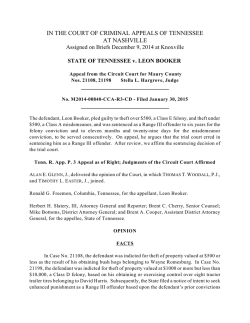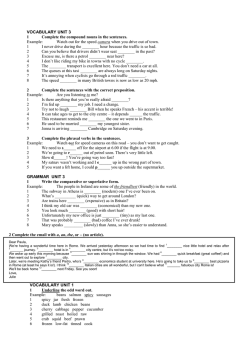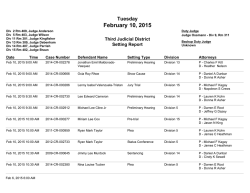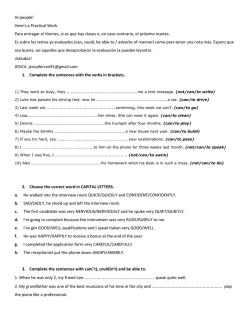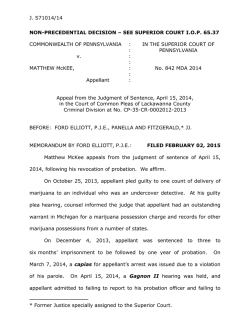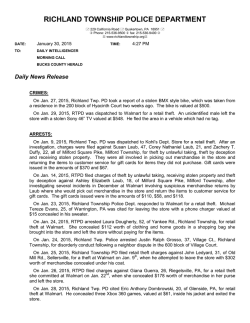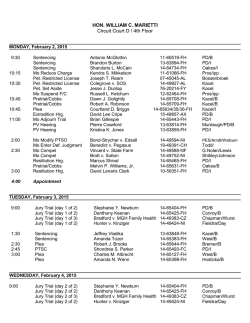
State of Tennessee v. Clebron Glade Mealer, Jr.
IN THE COURT OF CRIMINAL APPEALS OF TENNESSEE AT NASHVILLE Assigned on Briefs November 12, 2014 STATE OF TENNESSEE v. CLEBRON GLADE MEALER, JR. Appeal from the Circuit Court for Marshall County Nos. 2012-CR-149, 2013-CR-42 Forest A. Durard, Jr., Judge No. M2014-01110-CCA-R3-CD - Filed January 30, 2015 The Defendant-Appellant, Clebron Glade Mealer, Jr., was indicted by a Marshall County Grand Jury for two counts of theft of property valued at $10,000 or more but less than $60,000. See T.C.A. §§ 39-14-103(a), -105(a)(4). Count one was dismissed, and Mealer entered a guilty plea to the theft charge in count two, with the trial court to determine the length and manner of service of his sentence at a later hearing. When Mealer failed to appear at the sentencing hearing for his theft conviction, he was indicted for failure to appear, and a capias warrant was issued for his arrest. Some time later, Mealer was arrested and entered a guilty plea to the failure to appear charge. The trial court subsequently sentenced him as a Range II, multiple offender to consecutive sentences of nine years for the theft conviction and four years for the failure to appear conviction. On appeal, Mealer argues that his sentence is excessive and contrary to the law. Upon review, we affirm the judgments of the trial court. Tenn. R. App. P. 3 Appeal as of Right; Judgments of the Circuit Court Affirmed C AMILLE R. M CM ULLEN, J., delivered the opinion of the court, in which N ORMA M CG EE O GLE and R OBERT H. M ONTGOMERY, J R., JJ., joined. Donna Orr Hargrove, District Public Defender; and William J. Harold (on appeal and at trial) and Michael J. Collins (at trial), Assistant Public Defenders, for the Defendant-Appellant, Clebron Glade Mealer, Jr. Robert E. Cooper, Jr., Attorney General and Reporter; Caitlin Smith, Assistant Attorney General; Robert Carter, District Attorney General; and Weakley E. Barnard and Michael D. Randles, Assistant District Attorneys General, for the Appellee, State of Tennessee. OPINION Plea Submission Hearing. The State provided the following factual basis for Mealer’s guilty plea to theft of property valued at $10,000 or more but less than $60,000: [Toward] the end of July of 2012, John and Melinda [Myhr] . . . came to the Sheriff’s Department to report [that] several items of jewelry . . . had been taken from their home during a period of about July 15 to July 20, 2012. Coincidentally, they had been having some work done on their home. [Mealer] was either the workman or one of the workmen that had been in the home during that time[]frame. The jewelry in question was rather expensive. They provided receipts where they had purchased it. One item alone was [worth] nearly $10,000[.] Another item was $3730. Another one for a little over $1,000. And another one for a little over $3000. So they had receipts where they had purchased these items. During this same time[]frame, [Mealer] pawned the items at two different pawn shops, and so that would put him in very recent possession of stolen property. Sentencing Hearing. Crystal Gray, a probation and parole officer, testified that she had prepared Mealer’s presentence reports and that there were two convictions that had not been included in his reports because they were pending at the time the reports were completed. On July 25, 2012, Mealer violated his probation in an unrelated case in general sessions court. Then, on March 12, 2013, Mealer failed to appear in general sessions court, resulting a new charge unrelated to this case. She stated that Mealer was eventually found in Orlando, Florida, where he had been arrested on a simple battery charge. After serving ninety days in confinement for the simple battery conviction in Florida, Mealer was returned to Tennessee. On April 29, 2014, Mealer was sentenced to thirty days, time served, for his probation violation and ten days, time served, for his conviction for failure to appear in general sessions court. Gray stated that at the time Mealer committed the theft in this case, he was on probation in general sessions court. She also said Mealer had two prior felony -2- convictions for first-degree burglary. Gray explained that Mealer had access to the victims’ property because he had been hired by the victims to perform home repairs. Gray acknowledged that the victims’ property was returned to them. She said Mealer had informed her that he had gone to Florida and “ha[d] been clean over a year,” but she was unsure whether he had stopped using drugs on his own or whether he had completed a rehabilitation program. Mealer testified that he had spent ninety days at a rehabilitation center in Florida and had not taken any drugs since completing the program. He said he had been “clean” for approximately a year. He noted that his felony convictions were twenty-four years old. He stated that he intended to live with his mother and to work construction and maintenance jobs when released. Mealer claimed that John Weaver, who worked with him on the victims’ home, had, unbeknownst to him, taken the victims’ jewelry out of the house. He said Weaver told him that the jewelry belonged to his grandmother, which he had no reason to doubt, and that he was unable to pawn it because he did not have any photographic identification. Mealer acknowledged that he had pawned the jewelry for $800 and stated that he was unaware of the value of the jewelry at the time he pawned it. He said he received the simple battery conviction in Florida because he got into a dispute with the brother of a woman he was dating. At the conclusion of this hearing, the trial court sentenced Mealer as a Range II, multiple offender to consecutive sentences of nine years for the theft conviction and four years for the failure to appear conviction. ANALYSIS Mealer argues that his sentences are excessive and contrary to the law. Specifically, he asserts that his sentences are contrary to Tennessee Code Annotated section 40-35-102(1), which requires “a sentence justly deserved in relation to the seriousness of the offense,” and to sections 40-35-103(2) and (4), which require a sentence to be “no greater than that deserved for the offense committed” and “the least severe measure necessary to achieve the purposes for which the sentence is imposed.” He also argues, citing Code section 40-35102(5), that his crimes do not justify his lengthy sentences in confinement given the scarcity of prison resources. Mealer claims that the trial court, in imposing an effective sentence of thirteen years, failed to consider that he had completed a rehabilitation program and had not used drugs for a year, his prior felonies were more than twenty years old, his skills allowed him to find work immediately upon being released, and he was mislead into pawning the -3- stolen property. Mealer also claims that the court placed too much weight on the enhancement factors regarding his criminal record, probation violations, probationary status at the time of the offenses, and abuse of a position of trust. Finally, he argues that the trial court erred in imposing consecutive sentencing, given that his criminal history was not excessive and that he had completed treatment for his drug addiction. Because the trial court’s within-range sentences complies with the purposes and principles of the sentencing act, we uphold Mealer’s effective sentence of thirteen years in confinement. We note that the 2005 amendments to the sentencing act “served to increase the discretionary authority of trial courts in sentencing.” State v. Bise, 380 S.W.3d 682, 708 (Tenn. 2012). In light of this broader discretion, “sentences should be upheld so long as the statutory purposes and principles, along with any applicable enhancement and mitigating factors, have been properly addressed.” Id. at 706. The amendments to the sentencing act also “rendered advisory the manner in which the trial court selects a sentence within the appropriate range, allowing the trial court to be guided by–but not bound by–any applicable enhancement or mitigating factors when adjusting the length of a sentence.” Id. Because of this broader discretion, a trial court’s misapplication of an enhancement or mitigating factor does not invalidate the sentence imposed unless the trial court wholly departed from the 1989 Act, as amended in 2005. So long as there are other reasons consistent with the purposes and principles of sentencing, as provided by statute, a sentence imposed by the trial court within the appropriate range should be upheld. Id. Accordingly, this court reviews a trial court’s sentencing determinations under “an abuse of discretion standard of review, granting a presumption of reasonableness to within-range sentencing decisions that reflect a proper application of the purposes and principles of our Sentencing Act.” Id. at 707. Pursuant to the 2005 amendments to the sentencing act, a trial court must consider the following when determining a defendant’s specific sentence and the appropriate combination of sentencing alternatives: (1) The evidence, if any, received at the trial and the sentencing hearing; (2) The presentence report; (3) The principles of sentencing and arguments as to sentencing alternatives; (4) The nature and characteristics of the criminal conduct involved; (5) Evidence and information offered by the parties on the mitigating and enhancement factors set out in §§ 40-35-113 and 40-35-114; -4- (6) Any statistical information provided by the administrative office of the courts as to sentencing practices for similar offenses in Tennessee; and (7) Any statement the defendant wishes to make in the defendant’s own behalf about sentencing. T.C.A. § 40-35-210(b). The defendant has the burden of showing the impropriety of the sentence on appeal. Id. § 40-35-401(d), Sentencing Comm’n Cmts. The trial court shall impose “a sentence justly deserved in relation to the seriousness of the offense[.]” Id. § 4035-102(1). The court must consider the defendant’s potential for rehabilitation or treatment. Id. § 40-35-102, -103. In addition, the court must impose a sentence “no greater than that deserved for the offense committed” and “the least severe measure necessary to achieve the purposes for which the sentence is imposed.” Id. §§ 40-35-103(2), (4). When a defendant is convicted of one or more offenses, the trial court has discretion to decide whether the sentences shall be served concurrently or consecutively. Id. § 40-35115(a). The Tennessee Supreme Court has held “the abuse of discretion standard, accompanied by a presumption of reasonableness, applies to consecutive sentencing determinations.” State v. Pollard, 432 S.W.3d 851, 860 (Tenn. 2013). A trial court may order multiple offenses to be served consecutively if it finds by a preponderance of the evidence that a defendant fits into at least one of the seven categories in section 40-35115(b). T.C.A. § 40-35-115(b). This court must give “deference to the trial court’s exercise of its discretionary authority to impose consecutive sentences if it has provided reasons on the record establishing at least one of the seven grounds listed in Tennessee Code Annotated section 40-35-115(b).” Pollard, 432 S.W.3d at 861. At the conclusion of the sentencing hearing, the trial court held that Mealer was a Range II, multiple offender because he had four prior felony convictions. See T.C.A. § 4035-106(a)(1). Therefore, it found that Mealer faced a sentence of six to ten years for the Class C felony theft conviction and two to four years for the Class E felony failure to appear conviction. See id. §§ 40-35-112(b)(3), (5). The trial court applied mitigating factor (1), that Mealer’s “criminal conduct neither caused nor threatened serious bodily injury[.]” Id. § 40-35-113(1). It then applied enhancement factor (1), that Mealer had “a previous history of criminal convictions or criminal behavior, in addition to those necessary to establish the appropriate range[,]” because Mealer had at least seven misdemeanors convictions on his record in addition to his four felony convictions. Id. § 40-35-114(1). The court also applied enhancement factor (8), that Mealer “before trial or sentencing, failed to comply with the conditions of a sentence involving release into the community[.]” Id. § 40-35-114(8). The record shows that Mealer violated his probation in a unrelated case in 2011, which resulted in an extension of his -5- probation for eleven months and twenty-nine days. He also violated his probation in general sessions court on July 25, 2012. The trial court applied enhancement factor (13) because Mealer had been released on probation at the time he committed the theft in this case and because he was released on bail for this theft conviction when he committed the failure to appear offense. Id. §§ 40-35-114(13)(A), (C). The record shows that Mealer left Tennessee, failed to appear at his sentencing hearing for his theft conviction, and was later found in Florida, where he had been arrested and convicted of simple battery. At the sentencing hearing, defense counsel conceded that Mealer had a prior criminal record, had violated his probation in the past, and was on probation at the time he committed the offenses in this case. The trial court also applied enhancement factor (14), that Mealer “abused a position of public or private trust . . . in a manner that significantly facilitated the commission or the fulfillment of the offense[.]” Id. § 40-35-114(14); see State v. Kissinger, 922 S.W.2d 482, 488 (Tenn. 1996) (requiring the trial court to make findings that the offender occupied a position of trust based on the nature of the relationship he had with the victim and that the offender abused this position of trust when he committed the offense). In applying this factor, presumably only to the theft conviction, the court stated the following: You let someone come and work on your home, there is some degree of trust that you have to place in them, whether you call the pest control man to spray for bugs, call the carpenter to do something to the house, or the plumber or the electrician. There is always some degree of trust that has to be given to those people as they enter into the house, at least in my mind, there is.” The court stated that although it applied the aforementioned enhancement factors, factor (14) applied “to a lesser degree.” The court stated that “there were . . . some clues here that Mr. Mealer probably should have known that . . . this property was likely stolen, even if you accept his version of events to be the truth.” Following application of the aforementioned mitigating and enhancement factors, the trial court sentenced Mealer as a Range II, multiple offender to nine years for the theft conviction and four years for the failure to appear conviction. We conclude that the trial court did not impose an excessive sentence in this case. The record shows that the trial court appropriately considered the purposes and principles of the sentencing act before arriving at an effective sentence of thirteen years in confinement. Although Mealer contends, citing Code section 40-35-102(5), that his crimes do not justify a lengthy sentence in confinement given the scarcity of prison resources, he conceded at the sentencing hearing that he was a Range II, multiple offender. A review of his prior convictions shows that he possessed a criminal history “evincing a clear disregard for the laws and morals of society and evincing failure of past efforts at rehabilitation” and, therefore, was properly given “first priority regarding sentencing involving incarceration[.]” -6- T.C.A. § 40-35-102(5). The record shows that Mealer was not entitled to a shorter sentence and was a poor candidate for rehabilitation because he committed the theft offense in this case while on probation for an unrelated case and because he received his failure to appear charge after failing to attend the sentencing hearing for his theft conviction. Although Mealer does not claim that the court misapplied the enhancement factors, he argues that the court gave too much weight to these factors in setting his sentences. We note that “a trial court’s weighing of various mitigating and enhancement factors [is] left to the trial court’s sound discretion.” State v. Carter, 254 S.W.3d 335, 345 (Tenn. 2008). As long as the sentence is consistent with the purposes and principles of the sentencing act, this court is bound by the trial court’s sentencing decision. Id. at 345-46. Because Mealer’s sentences are consistent with the purposes and principles of the sentencing act, he is not entitled to relief on this claim. Finally, Mealer argues that the trial court erred in imposing consecutive sentencing because his criminal history was not excessive and he had completed treatment for his drug addiction. As previously noted above, in determining whether these two sentences would be served concurrently or consecutively, the trial court found that Mealer was “an offender whose record of criminal activity is extensive” and that he was being sentenced “for an offense committed while on probation[.]” See T.C.A. § 40-35-115(b)(2), (6). The court also determined that the failure to appear statute allowed him to impose consecutive sentencing for Mealer’s two convictions. See id. § 39-16-609(f). At the sentencing hearing, Mealer conceded that his criminal history included four felonies and that he had committed the offenses in this case while on probation. Based on the aforementioned authority, the court ordered that Mealer’s convictions would be served consecutively. The record fully supports the trial court’s findings as to the imposition of consecutive sentencing. Because the trial court imposed sentences within the appropriate range, considered the purposes and principles of the sentencing act, and considered the applicable enhancement and mitigating factors, we uphold Mealer’s effective sentence of thirteen years in confinement. See Bise, 380 S.W.3d at 706-07. The trial court’s judgments are affirmed. CONCLUSION The judgments of the trial court are affirmed. ___________________________________ CAMILLE R. McMULLEN, JUDGE -7-
© Copyright 2025
